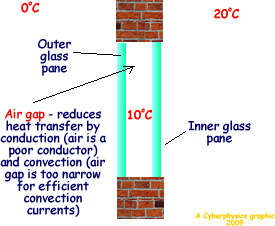Double Glazing have a small air gap between them.
In 'sealed units' this is sealed at low pressure (it is NOT a vacuum!) and the air is dried to prevent the misting up of the unit. In secondary glazing an inner frame is added to the existing window and the extra pane is often made to open out - some condensation will occur within such units. The trapped air in the gap is an insulator - it does not stop heat being conducted from the inner pane to the outer pane - but it does slow heat transfer by conduction down a lot! The air gap is too narrow to allow the air to circulate easily. This therefore reduces the rate of heat transfer by convection. The trapped air reduces the rate of heat loss through the window by conduction and convection. The room in the house therefore stays warmer for longer reducing heating costs. Heat radiates through air and glass - as it does so some of it is reflected (but this is virtually the same as for single glazing) and some of it is absorbed (mainly by the glass itself) this percentage increases as there is more glass. But overall heat transfer by radiation is hardly changed by double glazing a window - it is conduction and convection that change the most! Payback time on installing double glazing tends to be long - therefore double glazing installation is usually done in response to a range of other benefits - not just the savings from reduction of heating costs. Additional benefits
Common mistakes made in answering exam questions
|
Follow me...
|






